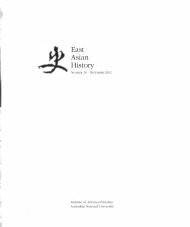Mujaku Dochu (1653-1744) and 17th-Century ... - East Asian History
Mujaku Dochu (1653-1744) and 17th-Century ... - East Asian History
Mujaku Dochu (1653-1744) and 17th-Century ... - East Asian History
You also want an ePaper? Increase the reach of your titles
YUMPU automatically turns print PDFs into web optimized ePapers that Google loves.
MUJAKU OOCHU<br />
55<br />
ing realisation at each of the ten stages, for as the Vijfidptimdtra-siddhi<br />
Sdstra (Wei-shih lun i!lilB) wrote,<br />
"Even though the nature of true thusness is really without distinction,<br />
in accordance with the superiority of merit ten sorts are established<br />
provisionally." This refers to the differences in the virtues that are realised.<br />
Therefore there are ten stages that are personally realised.153<br />
<strong>Mujaku</strong> also cited the metaphor of a lamp illuminating the darkness in the<br />
Mahdprajfidpdramitd Sdstra (Ta chih-tu lun) * J.lilB. If the lamplight is<br />
faint the darkness is not fully overcome. Only when it is totally illuminated<br />
does an extra lamp become useless. 1 54<br />
The third response was to cite works like the Miscellaneous Logia of<br />
Ch 'an Master Ming-pen of T'ien-mu 71:: § EJ!3:z1r:fljj.gffi¥iE of Chung-feng<br />
Ming-pen $*EJ!3:z1r (1264-1325), who said that once one has been<br />
enlightened, naturally there will be other enlightenments, like Ta_hui.155<br />
Finally, <strong>Mujaku</strong> cited the Collection of Ki5an Exercises in Daily Use by<br />
Master Kuge (Kuge nichiy6 kufO shu . B fflI;;Ii;JIO of Gid6 Shushin<br />
:llt)iliJffi (1325-88). When asked about the eighteen great enlightenments<br />
<strong>and</strong> innumerable minor enlightenments of Ta-hui, Shushin replied<br />
that they did not exist. <strong>Mujaku</strong> praised this reply for its decisiveness,<br />
unlike Chu-hung's dithering, inconclusive response.156<br />
This topic was later taken up by Hakuin <strong>and</strong> two of his disciples,<br />
including T6rei Enji, who were also aware of Ming Buddhist thinkers.<br />
This shows that the "Tokugawa Rinzai claim that it represents the unadulterated<br />
Sung Ch'an tradition" was wrong, in that it, "had in fact assimilated<br />
consciously or unconsciously many features characteristic of Ming Buddhist<br />
developments" . 157<br />
153 Wan'un reiu, MSS, 451a<br />
154 Wan 'un reiu, MSS, 451b; cf. brief reference<br />
in Rokuso dank yo suichoso, Part A: 62b.<br />
155HTC 122.<br />
15 6 Wa n'un reiu, MSS, 452b.<br />
157 Mohr, "Emerging from Nonduality,"<br />
p.251.<br />
Conclusion<br />
<strong>Mujaku</strong>'s scholarship then was concerned with the problems he<br />
perceived in the Zen of his day. Each element was meant to improve<br />
the discipline <strong>and</strong> organisation of the monastery <strong>and</strong> promote study <strong>and</strong><br />
meditation by the monks. Thus, he sought in Ming Buddhist scholarship<br />
responses to similar problems that Buddhism faced in Japan, but he often<br />
did not agree with the solutions proposed by the late-Ming Buddhists,<br />
especially Chu-hung. Rather, <strong>Mujaku</strong> wished to solve problems without<br />
violating what he conceived of as the orthodox tradition of Zen, something<br />
he thought some of the Chinese masters had done by incorporating<br />
Pure L<strong>and</strong> nienjo elements, by simplifying <strong>and</strong> watering down the<br />
provisions of the Pure Regulations of Pai-chang, <strong>and</strong> by not differentiating<br />
the Buddhist assertion of the emptiness of the Buddha-nature from<br />
the Confucian theories of Wang Yang-mingo While this was also to some

















